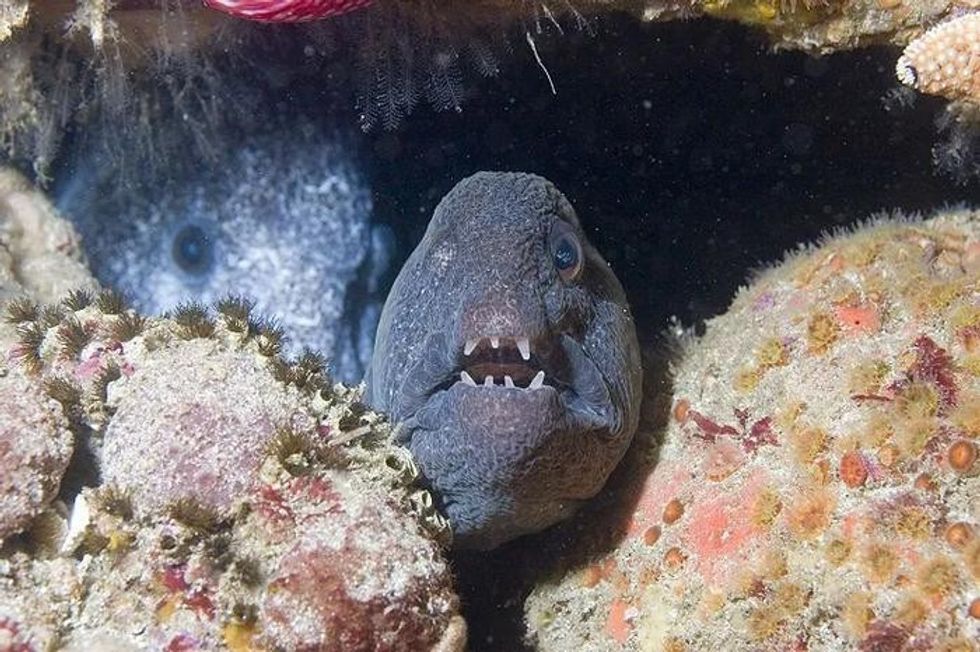The wolf eel (Anarrhichthys ocellatus) is a species of fish with an eel-like appearance. They are a part of the Anarhichadidae family, which is also known as the wolffish family.
Wolf eels are the only species under the Anarrhichthys genus. They can be found in the North Pacific, along the coasts of islands near Alaska, along the coast of California, and in the Sea of Japan. Wolf eels mainly occupy reefs, rock pilings, and dens where they live with their mate, usually for life.
Wolf eels have a peculiar appearance with a prominent head, sharp teeth, and a slender body. They look quite scary, but in reality, they hardly ever show aggression unless provoked.
These fish make use of their strong teeth to feed on mussels, sea urchins, crabs, and more. They are said to be quite voracious feeders. Some of the common predators who prey on wolf eels are harbor seals, sharks, and bigger fish.
Juvenile wolf eels have more predators, including the kelp greenling and rockfish, as they cannot protect themselves adequately. These fish have a long life and can live for more than 20 years in captivity.
For more relatable content, check out these lamprey facts and lungfish facts for kids.
Wolf Eel Interesting Facts
What type of animal is a wolf eel?
A wolf eel is basically a fish, even though its name suggests otherwise. These animals are found in the Northern Pacific Ocean.
What class of animal does a wolf eel belong to?
Wolf eels belong to the class Actinopterygii. They are in the family Anarhichadidae and have the scientific name Anarrhichthys ocellatus.
How many wolf eels are there in the world?
Though there is no exact estimation of the number of wolf eels present in the world, their population can be considered to be stable as they are not the common target of fisheries.
Where does a wolf eel live?
Wolf eels are present in the Northern Pacific and the Sea of Japan. They occur around the Aleutian Islands of Alaska and off the coast of northern California. Wolf eels are also seen in Puget Sound, where they are a major attraction for divers.
What is a wolf eel's habitat?
Juvenile wolf eels mostly spend their time in open waters. However, once they become adults, they settle down in dens, pilings, and rocky reefs.
Wolf eels are particularly fond of living in small cracks and crevices and often end up competing with octopuses who also have the same habitat. The slender body of the wolf eel helps it to settle in such narrow spaces.
They tend to stick their head out of their dens and wait for their prey. Once a pair of wolf eels finds a suitable den, they will make that their permanent home, unless they are driven out by a bigger wolf eel or an octopus.
Who do wolf eels live with?
A wolf eel is solitary when juvenile. However, once they reach maturity, males and females mate for life. Hence, they can be seen in pairs living in their den or any other suitable area, typically for life.
How long does a wolf eel live?
Wolf eels can live to become 20 years old or more in captivity.
How do they reproduce?
Once a wolf eel turns four years old it starts looking for a mate. Wolf eels mate for life, so once a suitable mate is found, the pair begin inhabiting a suitable den or rocky reef.
The female wolf eel lays up to 10,000 eggs after mating. Wolf eels are quite invested in taking care of their eggs.
Both male and female wolf eels are known to protect their eggs by wrapping their bodies around them.
Additionally, one parent always stays near the eggs, while the other goes out of the den in search of food. After a period of about 16 weeks, the eggs hatch and the larvae float towards the upper part of the ocean or the sea, where they spend nearly two years of their lives.
What is their conservation status?
The conservation status of the wolf eel has been marked as Least Concern by the International Union for Conservation of Nature (IUCN). Though the exact population of these fish remains unknown, their population is not severely affected by any major threats as they are not usually targeted for fishing or harvesting.
However, climate change leading to a rise in the temperature of seas and oceans is likely to have a negative effect on these creatures who prefer colder waters.
Wolf Eel Fun Facts
What do wolf eels look like?
The appearance of juvenile wolf eels (Anarrhichthys ocellatus) differs from adults. When young, this species has an orange-toned body with black spots which are located along the posterior region. A juvenile wolf eel appears quite noticeable due to this bright color.
As wolf eels grow older, they start losing this bright orange color and turn into gray, dark-olive, or brownish-gray individuals. Adults of this species also have spots on their bodies and heads.
Their bodies have scales that remain embedded, giving a leathery feel to the species. Adult males are especially known to have bulging heads and prominent lips.
They also have a much more wrinkled face when compared to a female (which is why some people argue that male wolf eels are uglier fish than females and that wolf eel females are not ugly fish) Male and female wolf eels also differ in color, as the former has a lighter body color.
The jaws in these creatures are provided with sharp teeth. Overall, wolf eels look pretty scary and ferocious, which aids them in scaring off predators.

How cute are they?
Wolf eels are not really cute. Their sharp teeth, prominent forehead, and medium to large eyes give them quite a scary appearance. However, just like any other marine animal, this species also provides us with a fascinating an insight into the underwater world.
How do they communicate?
Though the exact methods of communication are not known among wolf eels, since they belong to the order Perciformes it can be assumed they can communicate through visual and chemical methods like other fish of this order.
How big is a wolf eel?
The length of the body of a wolf eel can be up to 8 ft (2.4 m). Some are measured at 8.2 ft (2.5 m), as well.
These creatures have quite a long and slender body. When compared to the green wolf eel, which has a length of 1 ft 6 in (45.7 cm), wolf eels are nearly eight times longer!
How fast can a wolf eel swim?
Wolf eels are known to be slow swimmers; they move their bodies like a snake by making S-shaped movements. They are also curious by nature and have been noted to gently swim up to divers.
How much does a wolf eel weigh?
Wolf eels are quite large and their maximum recorded body weight is 41 lb (18.5 kg).
What are their male and female names of the species?
Males and females belonging to this species are known as male wolf eels and female wolf eels.
What would you call a baby wolf eel?
Baby wolf eels are known as larvae or fries.
What do they eat?
Adult wolf eels are carnivorous in nature. They mainly feed on clams, sea urchins, mussels, crabs, and smaller fish. These creatures have sharp teeth in their jaws which help them in these crushing hard-shelled marine animals. Larvae mainly rely on plankton as food until they are old enough to eat mussels and crabs.
Are they poisonous?
Wolf eels are not dangerous, venomous, or poisonous. In fact, their meat is described as being edible and sweet. Wolf eel meat is quite a delicacy in some places in the world.
Would they make a good pet?
Wolf eels are not commonly seen as pets, however, they are kept in various public aquariums. It is only possible to keep a wolf eel as a pet if all its needs are met and the right kind of environment is provided.
Did you know...
The skin of wolf eels is covered with a layer of slime, which gives them protection and primarily acts as their immune system.
The patterns of spots in wolf eels are distinct and scientists can differentiate between wolf eels based on this pattern.
Female wolf eels massage their eggs from time to time to ensure that there is an adequate supply of oxygen from the water going to the eggs.
Are wolf eels friendly?
In general, wolf eels are described as being mild-mannered and gentle. They do not show aggressive behavior towards humans. In areas where divers are known to frequent wolf eels even swim near them out of curiosity. However, if provoked, wolf eels can resort to biting. A wolf eel bite can be quite painful, considering their sharp teeth.
What is the difference between a wolf eel and other eels?
Even though the Anarrhichthys ocellatus fish has the common name 'wolf eel', they are not actually eels. Unlike a real eel, Anarrhichthys ocellatus fish have pectoral fins which are located behind their heads.
This is a characteristic feature of fish and is not seen in a true eel. Hence, a wolf eel is basically a marine fish species with an eel-like appearance. Additionally, a true eel is a member of the order Anguilliformes, while a wolf eel belongs to the order Perciformes.
Here at Kidadl, we have carefully created lots of interesting family-friendly animal facts for everyone to discover! Learn more about some other fish from our catfish facts and drum fish facts pages.
You can even occupy yourself at home by coloring in one of our free printable Wold Eel coloring pages.









